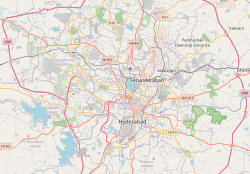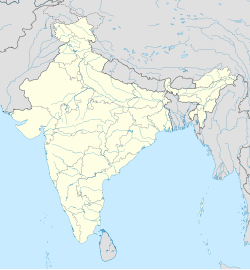Barkas, Hyderabad
This article needs additional citations for verification. (October 2018) |
Barkas | |
|---|---|
| Coordinates: 17°18′47″N 78°28′58″E / 17.31306°N 78.48278°E | |
| Country | |
| State | Telangana |
| District | Hyderabad |
| Metro | Hyderabad |
| Established | 1903 |
| Founded by | Nizam Mir Mahboob Ali Khan Siddiqi Bayafendi Asaf Jah VI |
| Named for | Barracks |
| Government | |
| • Body | GHMC |
| Languages | |
| • Official | Arabic, Urdu |
| Time zone | UTC+5:30 (IST) |
| PIN | 500 005 |
| Vehicle registration | TS |
| Lok Sabha constituency | Hyderabad |
| Vidhan Sabha constituency | Chandrayangutta |
| Planning agency | GHMC |
| Website | telangana |
Barkas is a neighborhood in Hyderabad, India, located in the old city area of Hyderabad. The name "Barkas" is believed to be derived from the English word "Barracks". The old Arabs pronounced Barracks as Barkas in their Arabic flow. Barkas served as the military Barracks of the Nizam of Hyderabad.
The Chaush were brought from Yemen to work in the former Hyderabad State as military men for the Nizams. It is said that especially when it came to safeguarding the Deccan, the 7th Nizam had absolute trust on these Arabs.[1] Another less popular version states that "The name 'Barkas' is derived from 'Wadiya Barkas', which was a colony in Saudi Arabia. A regiment from Barkas in Arabia had been called to Hyderabad. Thus most of the residents of this colony were originally inhabitants of Yemen and Arabia."
History
[edit]Before Indian independence, Barkas served as the military Barracks of the Nizam of Hyderabad. The Nizams were surrounded by hostile rulers in the Deccan and chose to employ Arabs instead of the local military for the safeguarding of his family. These Arabs formed the bulk of the Nizams' personal army and were more reliable as they could not defect to the rival states unlike locals and were trustworthy.
Many mentions state that the last Nizam loved their trait of Loyalty and trusted them more than anyone else. The Arab population increased during this period, settling in mainly in barracks on the outskirts of the walled, gated city.
Culture
[edit]Barkas is known for its vibrant culture that reflects the rich heritage of its predominantly Yemeni community. This unique culture is characterized by a strong sense of community, traditional hospitality, and specific social practices.[2]
Community and Togetherness
The residents of Barkas are known for their deep-rooted sense of community and togetherness. Families often gather in communal spaces, fostering strong familial ties and friendships. The spirit of mehmaan nawazgi (hospitality) is particularly prominent, with Barkas residents taking pride in welcoming guests and ensuring they feel at home. This tradition is celebrated throughout Hyderabad, as locals are known for their generous and warm hospitality.
Architecture
A defining feature of homes in Barkas is the majlis, a traditional gathering area where family and friends come together to socialize, discuss matters of importance, and share meals. The majlis serves as a cultural cornerstone, promoting social interaction and reinforcing bonds within the community. It is not uncommon for gatherings to involve discussions on various topics, from community issues to personal stories, further strengthening the communal ties.
Language and Communication
The primary language spoken in Barkas is Urdu, Arabic spoken by mostly elders reflecting the Yemeni heritage of its inhabitants. which facilitates communication within the diverse population of Hyderabad. The bilingualism enriches cultural expression, allowing for a blend of Yemeni and Hyderabadi traditions in everyday life.
Ramadan Celebrations
Ramadan nights in Barkas are especially vibrant, marked by a series of communal activities and religious observances. Families prepare elaborate iftar meals to break their fasts, often inviting neighbors and friends to join in the celebrations. The atmosphere during Ramadan is one of joy and spirituality, with homes and streets adorned for the occasion, creating a festive ambiance. Tarawih, communal gatherings, and cultural exchanges during this month further highlight the strong communal spirit of Barkas.
Attire
[edit]Arab Lungi
[edit]The Arab lungi izaar in Arabic (إِزَار), also known as Maʿawaz (مَعَوَز), Futah (فُوطَة), Wizar (وِزَار), Maqtab (مَقْطَب) is a traditional garment made from high-quality rayon fabric on handlooms. It is known for its softness and comfort, making it suitable for the hot climate of the region. The lungi is stitched in the middle and is designed to be round, allowing for ease of movement. Due to its craftsmanship and the quality of material used, the Arab lungi is relatively expensive.
Taiban
[edit]In contrast to the lungi, the taiban is a rectangular piece of cloth that is open at all four corners and is not stitched in the middle. Generally made from a thicker fabric, the taiban offers a different style of draping, allowing it to be worn in various ways. This garment is favored for its versatility and is commonly worn.
Jubbah
[edit]The jubbah, also referred to as thawb, kandura, or dishdasha, is a long, flowing robe worn by men. It is characterized by its modest design and is typically ankle-length, providing coverage while allowing for comfort. The jubbah can be made from various materials, depending on the occasion and the weather. It is often adorned with embroidery or patterns and is a staple in formal and religious settings.
Mushajarah
[edit]The mushajarah, also known as ghutrah or shemagh, is a traditional headscarf worn by men. Made from lightweight cotton, it is usually white or checkered in design. The mushajarah is worn to protect the head and face from the sun and dust. This garment serves not only practical purposes but also symbolizes cultural identity and heritage.
Footwear
[edit]The traditional footwear associated with Barkas is known as naal in Arabic but is more commonly referred to as Arba Chappal in Hyderabad. These sandals are typically made from leather and are characterized by their durability and comfort. They are designed to complement traditional attire and are often worn during both casual and formal occasions.
Main attractions
[edit]Barkas houses a lot of mosques especially the 'Jama'a Masjid'.
Barkas Maidan, historically significant during the Nizam's rule, served as a vital training and gathering ground for the army. Located in the Barkas area of Hyderabad, this maidan was essential for military drills and exercises, reflecting the strategic importance of the Yemeni troops who settled in the region.
In the late 19th and early 20th centuries, the Nizam's relied on these troops for their loyalty and military prowess. The maidan facilitated various military functions, including parades and ceremonial events, underscoring its role as a center for the military.
'Mandi Road' which is the main road of Barkas going to the Shamshabad Airport from Chandrayangutta crossroads. It is lined with many restaurants serving a variety of Arab cuisine. This road is named after the most popular Arab dish - the Mandi.[3]
Cuisine
[edit]The cuisine of Barkas is a reflection of its Yemeni heritage, enriched by various influences. It features of traditional dishes, introduced by the Chaush or Arab community.
Notable dishes include Marag, Murtabaq, Shorba, Harira, Mandi, Kabsa. Other popular items are Tas Kabab, Lukhmi, Sheer Khurma, Qubani Ka Meetha and Malida.
Barkas also showcases Arabic dishes such as Majboos, and Shawarma. A local specialty is a sweet version of Harees, available exclusively in Barkas[4]. Recently, Mandi, a Yemeni rice dish, has gained popularity, leading to the opening of several restaurants in the area.[3]
Organisations
[edit]Barkas is home to "Jaundice Medicine Barkas", a non-profit organization providing free medication for Jaundice disease. The organisation is led by a team from Al Qureshi tribe.[citation needed]
Sabil Ul Khair is another non-profit organization established in Barkas by Shaikh Saleh Bin Salam Bahattab catering to the social development of the area. And it offers various schemes for the social development of the locals, like providing funds for the marriage of girls belonging to poor households, funeral services etc.
Barkas also has a non-profitable organization called "Bait-ul-Maal". The sole intent of this organization is to help needy people and looking for the betterment of communities.
See also
[edit]External links
[edit]- Video of Soldiers of NIZAMS of HYDERABAD
- Barkas: A small Yemen in Hyderabad, Yemeni Lifestyle is following by barkas people
- Barkas Street, A Mini Arabia In Hyderabad
References
[edit]- ^ A home for the Chaush community, The Hindu, 25 Sep 2011
- ^ "Little Arabia - Times of India". The Times of India. Retrieved 25 July 2018.
- ^ a b Aneez, Prabalika M. Borahzeenab (18 July 2014). "So, what's khaas about Barkas?". The Hindu. ISSN 0971-751X. Retrieved 25 July 2018.
- ^ "The haleem debate: Why some Indian Muslims are renaming the Ramzan delicacy 'daleem'".
Further reading
[edit]- حيدرأباد والحضارمة والمحاولات العبثية لطمس هويتها الإسلامية, Al-Ayyam (Yemen), 14 May 2007
- Ababu Minda Yimene, An African Indian community in Hyderabad, Cuvillier Verlag, 2004, pg 201

